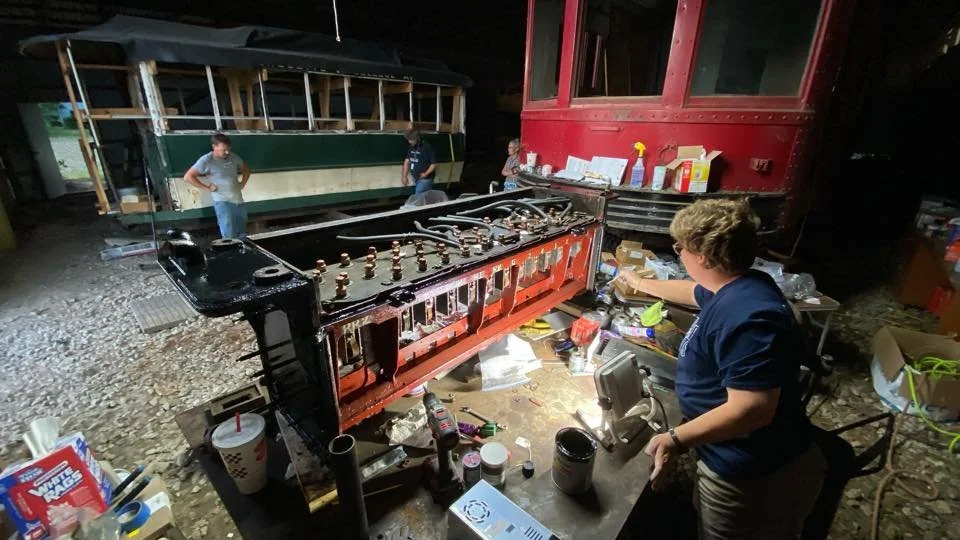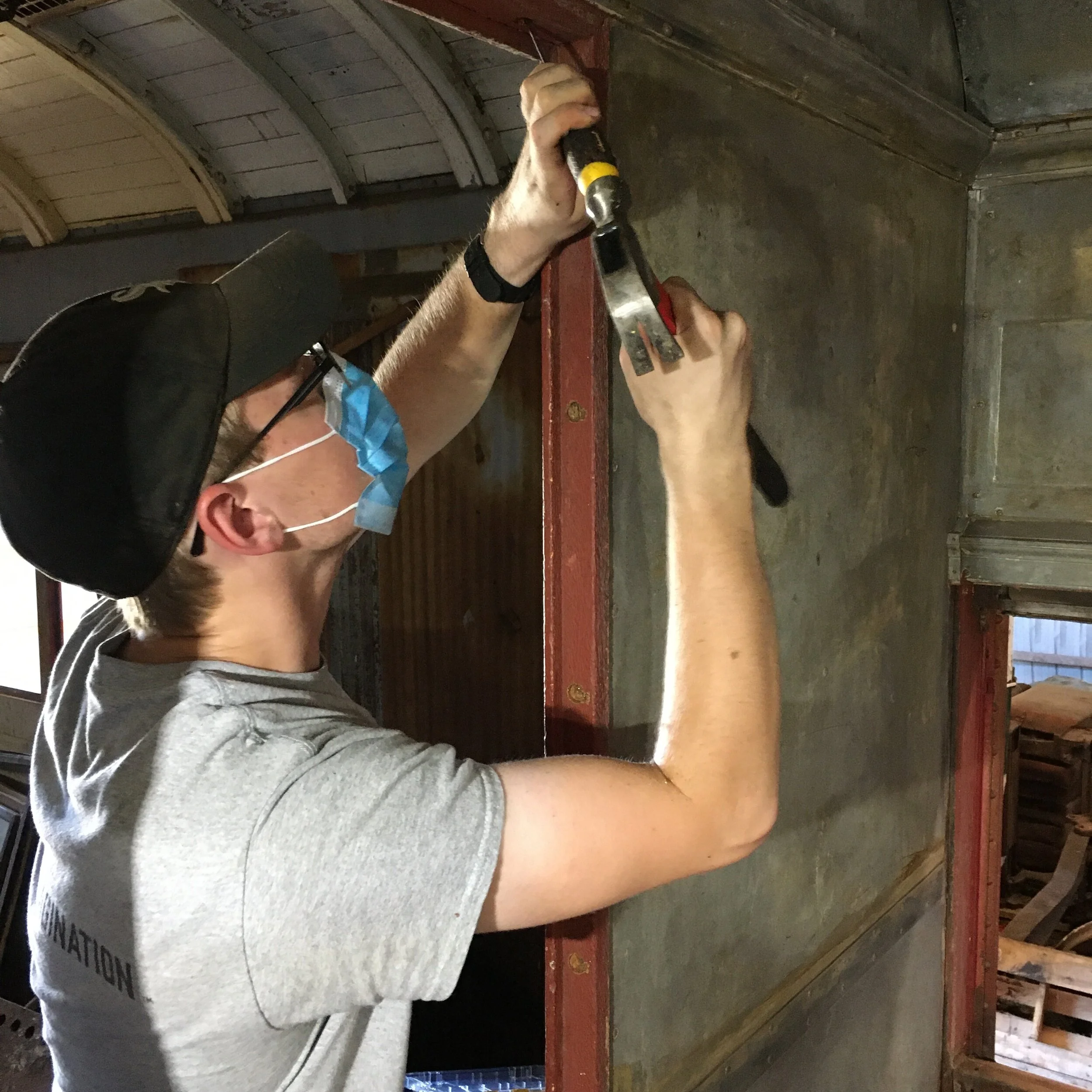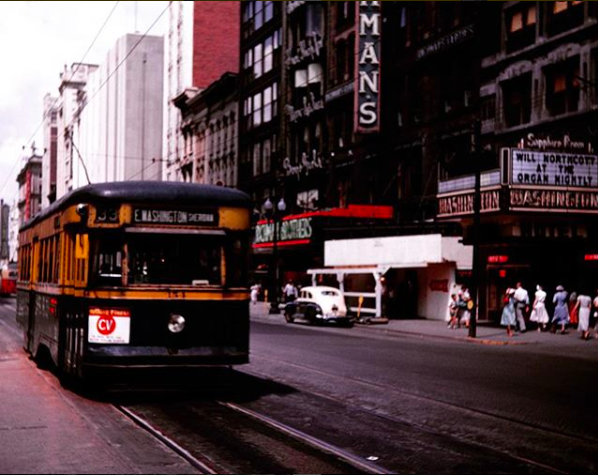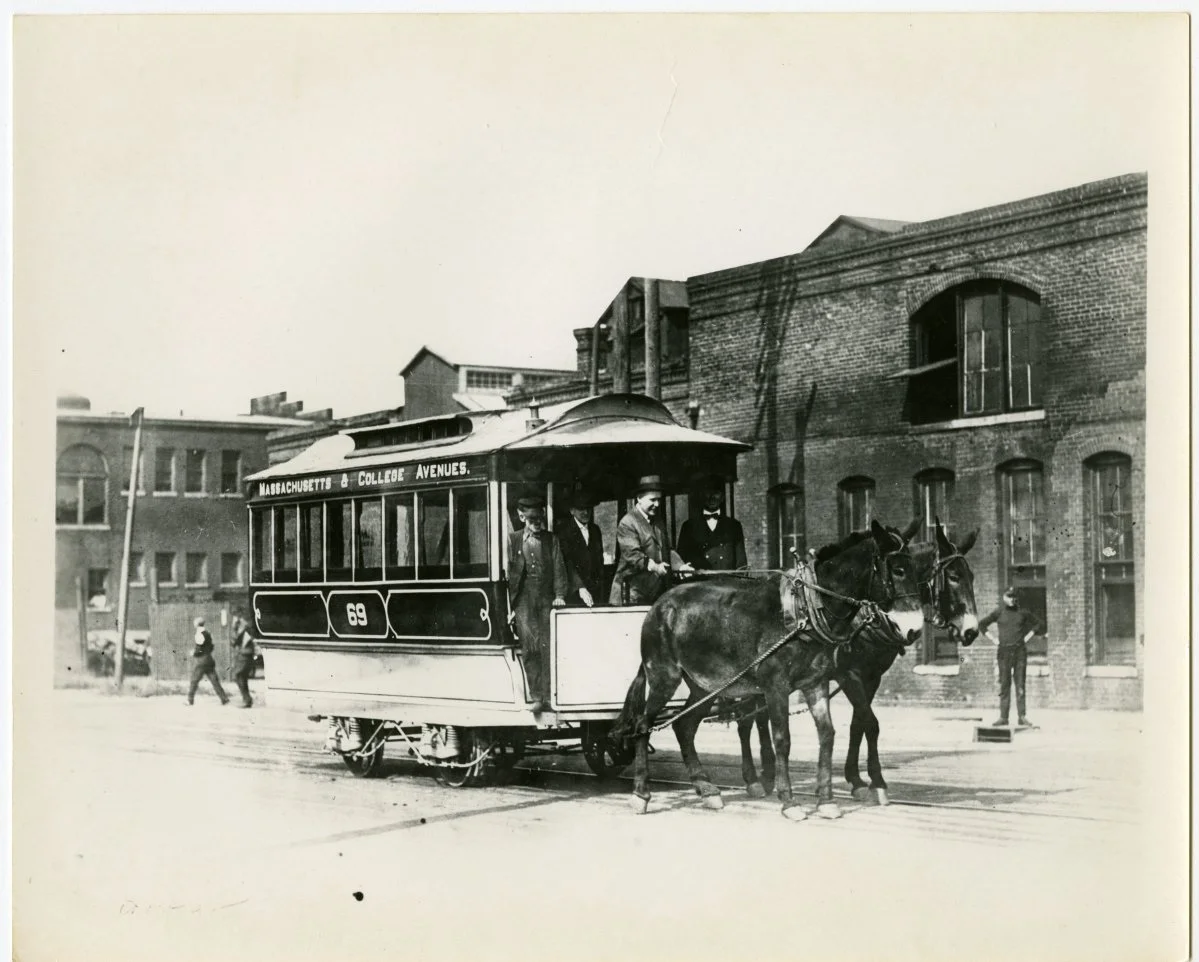Live Wire Blog
Indiana History, Culture, Tech, Art & Economics
Company News & Announcements
Electricity moves at the speed of light - so does our effort to preserve Indiana's electric railway heritage. Find developments, news, fun articles and more via our Live Wire Blog.
News Room
The Hoosier Heartland Trolley Company is excited to announce that interurban No. 429 has received a $4,999 Heritage Support Grant from the Indiana Historical Society. The grant project will provide for new boarding steps, baggage room ladders and the iconic “cowcatcher” or pilot on the front, which resembles a snowplow and prevents objects from being caught underneath the train.
A century ago, Indiana's high-speed interurban electric trains empowered Hoosiers to pursue an education, expand economic opportunity, visit loved ones, quickly ship perishable goods - and, electrify rural communities. For the first time since 1940, more than 83 years later, interurban no. 429 lives again as the only original Indiana interurban operational within the state. This accomplishment is thanks in no small part to two Heritage Support Grants provided by the Indiana Historical Society and made possible by Lilly Endowment, Inc., more than 3,500 volunteer hours and nearly $100,000 in total contributions.
Interurban No. 429 has received a $40,000 Heritage Support Grant provided by the Indiana Historical Society and made possible by Lilly Endowment, Inc. The grant project will allow the car to move and stop under its own power for the first time since 1940, marking a significant achievement on the journey to establishing the state’s only electric heritage railroad. The organization is raising $6,000 for a 15 percent match in new fundraising as part of the grant, amplifying donor impact by more than six-fold.
Electrify 429, a campaign to revive one of Indiana’s last electric interurban cars, has received a $4,255 grant from the National Railway Historical Society’s Heritage Grant program. The award is made with support from the NRHS Indianapolis Chapter, and is one of 21 national grants awarded from the NRHS convention in Los Angeles, California. The organization is actively fundraising a $1,000 match to coincide with $1,100 in funds already raised for the grant project.
2021 was another year of growth and progress for the nonprofit Hoosier Heartland Trolley Company, as the organization not only moved Union Traction Co. interurban no. 429 closer to revival, but also expanded capacity and resources. We hope you find our progress inspiring and consider a tax-deductible donation or membership to support this project, which will facilitate educational, community placemaking and economic development opportunities for Hoosiers.
2021 marks another year of significant progress, being one of the most productive working seasons for our organization to date. We’d like to extend our sincerest “thank you” to our volunteers, donors and the community for continued support, as we further our mission of preserving and telling the story of Indiana’s rich electric railroad history. We believe that our story of community, industrial innovation and connecting people with places is relevant now more than ever. Despite the disruptions and hardships brought by the global COVID-19 pandemic, with your continued support, we have been able to steadily and safely make progress on many organization-wide and project-level goals - setting our organization up for sustained success in 2022.
The nonprofit Hoosier Heartland Trolley Company has received the donation of a rare, wooden 1898-built locomotive designed by General Electric for use at Singer’s South Bend cabinetry factory. The locomotive is one of the first electric locomotives built by GE at its Schenectady, New York plant. At one time, it was the oldest-known operating electric locomotive in preservation. The locomotive was donated to the organization in July 2021 by the family of the late David W. Peat - an Indianapolis native, electrical engineer and historian.
HHTC’s tremendous volunteers have worked on average three to four days per week, collaborating in small groups with COVID-19 precautions. Careful planning and project management has enabled the near completion of Phase One, cosmetic restoration of the car’s interior smoking section, along with the beginning of Phase Two, mechanical and electrical restoration of the car to operating condition.
The Hoosier Heartland Trolley Company is excited to announce that Electrify 429 has received an $8,000 grant from the Indiana Historical Society’s Heritage Support Grant Program; in addition to a $1,200 match from a private trust and generous donors. Heritage Support Grants are provided by the Indiana Historical Society and made possible by Lilly Endowment, Inc.
The Hoosier Heartland Trolley Company is excited to announce that Electrify 429 has received a $3,000 grant from Tom E. Dailey Foundation. Electrify 429 is a capital campaign for the operational restoration of one of Indiana’s last interurbans – an intercity electric railway car. This grant will be applied towards the cosmetic restoration of the car’s smoking section as phase one of a four-phase restoration plan, which is already underway at a private facility near Indianapolis.
From president Austin Mace and the Board of Directors. 2019 was a banner year for the Hoosier Heartland Trolley Company, with a number of projects starting throughout the organization and taking shape. As year-end approaches, please consider a tax-deductible donation to our Electrify 429 campaign or general fund.
Historic rail from Indianapolis’ well-known streetcar system has been awarded to the nonprofit Hoosier Heartland Trolley Company through a collaborative effort amongst Midtown Indy, the Arts Council of Indianapolis and IndyGo. The rail from College Avenue once carried the company’s Indianapolis Railways streetcar No. 153, which is the last one known in existence.
Hoosier Heartland Trolley Company and Headwaters Junction, Inc. announced today their intent to operate one of the Company’s historic interurbans, No. 429, as a part of Headwaters Junction’s growing fleet of attractions. The 429 once frequented Fort Wayne in the 1920s and 30s, shuttling passengers throughout the state in the era before the highway system.
It’s hard to believe that already one year has gone by since the founding of our organization. As a quick introduction, my name is Austin Mace and I am the current president of the Hoosier Heartland Trolley Company (HHTC). I wanted to take this opportunity to highlight what we’ve accomplished in the past 365 days, where we’re going next and how we got here in the first place.
As of 4:29 p.m. on 4/29/2019, a group of young preservationists are pleased to announce the Electrify 429 capital campaign. Electrify 429 is a project of the Hoosier Heartland Trolley Co. to restore Indiana Union Traction Company No. 429 to operation – one of the last remaining interurbans from Indiana’s world-famous electric railroad system of the early 20th century.
At this point-in-time, our team rolled up our sleeves and entered the scene in crisis mode as part of a serious effort to acquire as many of the remaining electric railway cars as possible. Although beaten and battered, these cars were the last glimpses into an industry that built Indiana into what it is today - a cultural phenomenon that employed thousands, moved millions, and opened Indiana up to economic possibilities never before seen nor contemplated.
The Hoosier Heartland Trolley Company was awarded a $3,500 grant to relocate and stabilize the last-remaining Indianapolis streetcar, Indianapolis Railways No. 153, on Saturday, October 27, 2018. This rare grant request fostered a unique collaboration between the Marion County Historic Preservation Fund of the Central Indiana Community Foundation and Indiana Landmarks.
-Long days, late nights, conference calls, precision logistics, all while balancing full-time careers, family obligations, etc. This is what occurs day-in and day-out within preservation groups across the country. For our new nonprofit organization near Indianapolis, it has been no exception relocating Indiana’s last surviving trolleys.
A group of historic preservationists is pleased to announce the formation of the Hoosier Heartland Trolley Co. The group is a forming nonprofit preservation organization dedicated to the interpretation, preservation, and operation of historic railroad artifacts significant to Indiana’s rich, yet mostly forgotten electric railway history.
Live Wire Culture
So, what does a gravel pit office, tire shed, house, an outdoor cabin and a helicopter ride have in common?
-A captivating story full of twists and turns, legendary artifacts from Indiana’s past, and forward-thinking Hoosiers that have worked tirelessly across generations to preserve our world-renowned electric railway heritage.
With the interurban system dissolving in 1941 and streetcar systems converting to buses in the 1950s, many alive today do not remember nor even know the state had one of the world’s greatest transportation networks. In the 1920s, the electric railway system peaked with more than 15,000 operating trolleys and more than 2 million passengers in a year. Cars would depart the traction terminal in Indianapolis (trolley station) nearly every minute for destinations across the state, once passing the steps of the Indiana Statehouse. With the conclusion of the Golden Age of railroading in America, began the railway preservation movement.
Before the traditional steam railroads came along, there were two options for transportation: horse or by foot. The advent of railroads made travel between towns convenient for the first time in Indiana’s history. This level of convenience was increased even further by the services of the interurban railroads. The interurbans wouldn’t only stop in town but could pick up additional passengers at almost any crossing.
-This level of convenience, however, came at a cost to the interurbans.
The level of service delivered by the interurban companies opened up business and educational opportunities to Indiana’s rural citizens during the early 1900s. Rufus Thomas was one of those Hoosiers - sparking a future of opportunity through the interurban system that had never been an option for him.
The war effort - a time requiring the country to band together. The Indianapolis Railways streetcar system was a culture and art-filled part of that effort - encouraging Indianapolis citizens to support in various ways from buying war bonds to donating blood to the American Red Cross.
Live Wire Tech
2021 was another year of growth and progress for the nonprofit Hoosier Heartland Trolley Company, as the organization not only moved Union Traction Co. interurban no. 429 closer to revival, but also expanded capacity and resources. We hope you find our progress inspiring and consider a tax-deductible donation or membership to support this project, which will facilitate educational, community placemaking and economic development opportunities for Hoosiers.
Electricity – the invention that defined the beginning of the 20th century. Indianapolis’ streetcar system adopted the technology in the 1890s – ushering in the new century with it. Beginning in 1864, transportation in Indianapolis was provided by horse or mule-drawn carriages on rails through the street. By 1890, Citizens Street Railroad Company, the dominant streetcar company in the city, was operating 260 cars with some 1100 horses and mules. The inefficiency ultimately proved to be problematic for the City of Indianapolis.
Leslie Haines was born in 1883 in rural Hamilton County, Ind. at Carmel, which numbered less than 400 residents at the time. Following his dream, Haines enlisted in 1906 and circumnavigated the globe in Roosevelt’s Great White Fleet, training under Dr. Lee DeForest, a leader in the development of wireless technology. Meanwhile, the Union Traction Company of Indiana had set up shop in Carmel, allowing Carmel residents and storeowners to tap into a valuable new asset: electricity.
In 1935, Indiana Railroad, which was the dominating interurban (high-speed electric train car between cities) route resulting from the acquisition of nearly every interurban line in Central Indiana, was looking for ways to cut costs and standardize equipment. Competition from automobiles and busses were injuring the interurban line’s finances, as the personalization and ease of these modes of transportation had great appeal.
Live Wire Art
The war effort - a time requiring the country to band together. The Indianapolis Railways streetcar system was a culture and art-filled part of that effort - encouraging Indianapolis citizens to support in various ways from buying war bonds to donating blood to the American Red Cross.
Live Wire Economics
Before the traditional steam railroads came along, there were two options for transportation: horse or by foot. The advent of railroads made travel between towns convenient for the first time in Indiana’s history. This level of convenience was increased even further by the services of the interurban railroads. The interurbans wouldn’t only stop in town but could pick up additional passengers at almost any crossing.
-This level of convenience, however, came at a cost to the interurbans.
In 1935, Indiana Railroad, which was the dominating interurban (high-speed electric train car between cities) route resulting from the acquisition of nearly every interurban line in Central Indiana, was looking for ways to cut costs and standardize equipment. Competition from automobiles and busses were injuring the interurban line’s finances, as the personalization and ease of these modes of transportation had great appeal.



























